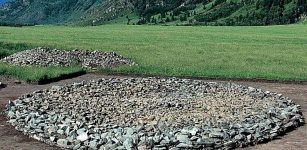How Many Ice Ages Has The Earth Had, And Could Humans Live Through One?
AncientPages.com - First, what is an ice age? It’s when the Earth has cold temperatures for a long time – millions to tens of millions of years – that lead to ice sheets and glaciers covering large areas of its surface.
We know that the Earth has had at least five major ice ages. The first one happened about 2 billion years ago and lasted about 300 million years. The most recent one started about 2.6 million years ago, and in fact, we are still technically in it.
Greenland - Pixabay
So why isn’t the Earth covered in ice right now? It’s because we are in a period known as an “interglacial.” In an ice age, temperatures will fluctuate between colder and warmer levels. Ice sheets and glaciers melt during warmer phases, which are called interglacials, and expand during colder phases, which are called glacials.
Right now we are in the most recent ice age’s warm interglacial period, which began about 11,000 years ago. https://www.youtube.com/embed/I4EZCy14te0?wmode=transparent&start=0 Earth’s climate goes through warming and cooling cycles that are influenced by gases in its atmosphere and variations in its orbit around the sun.
What was it like during the ice age?
When most people talk about the “ice age,” they are usually referring to the last glacial period, which began about 115,000 years ago and ended about 11,000 years ago with the start of the current interglacial period.
During that time, the planet was much cooler than it is now. At its peak, when ice sheets covered most of North America, the average global temperature was about 46 degrees Fahrenheit (8 degrees Celsius). That’s 11 degrees F (6 degrees C) cooler than the global annual average today.
That difference might not sound like a lot, but it resulted in most of North America and Eurasia being covered in ice sheets. Earth was also much drier, and sea level was much lower, since most of the Earth’s water was trapped in the ice sheets. Steppes, or dry grassy plains, were common. So were savannas, or warmer grassy plains, and deserts.
Many animals present during the ice age would be familiar to you, including brown bears, caribou and wolves. But there were also megafauna that went extinct at the end of the ice age, like mammoths, mastodons, saber-toothed cats and giant ground sloths.
There are different ideas about why these animals went extinct. One is that humans hunted them into extinction when they came in contact with the megafauna.
Excavating a mastodon skeleton at Burning Tree Golf Course in Heath, Ohio, December 1989. The skeleton, found by workers who were digging a pond, was 90% to 95% complete and more than 11,000 years old. James St. John/Flickr, CC BY
Yes, people just like us lived through the ice age. Since our species, Homo sapiens, emerged about 300,000 years ago in Africa, we have spread around the world.
During the ice age, some populations remained in Africa and did not experience the full effects of the cold. Others moved into other parts of the world, including the cold, glacial environments of Europe.
And they weren’t alone. At the beginning of the ice age, there were other species of hominins – a group that includes our immediate ancestors and our closest relatives – throughout Eurasia, like the Neanderthals in Europe and the mysterious Denisovans in Asia. Both of these groups seem to have gone extinct before the end of the ice age.
There are lots of ideas about how our species survived the ice age when our hominin cousins did not. Some think that it has to do with how adaptable we are, and how we used our social and communication skills and tools. And it appears that humans didn’t hunker down during the ice age. Instead they moved into new areas.
For a long time it was thought that humans did not enter North America until after the ice sheets started to melt. But fossilized footprints found at White Sands National Park in New Mexico show that humans have been in North America since at least 23,000 years ago – close to the peak of the last ice age.
This article is republished from The Conversation under a Creative Commons license. Read the original article .![]()
More From Ancient Pages
-
 Timeline Of Greek Dark Ages And Renaissance Is Wrong, New Research Shows
Featured Stories | Nov 13, 2024
Timeline Of Greek Dark Ages And Renaissance Is Wrong, New Research Shows
Featured Stories | Nov 13, 2024 -
 Ancient Ruins Of Quilmes: Largest Pre-Colombian Settlement In Argentina
Featured Stories | Mar 28, 2019
Ancient Ruins Of Quilmes: Largest Pre-Colombian Settlement In Argentina
Featured Stories | Mar 28, 2019 -
 Mystery Of The Horrible ‘Thing’ Found In A Dominican Monastery
Featured Stories | Sep 4, 2023
Mystery Of The Horrible ‘Thing’ Found In A Dominican Monastery
Featured Stories | Sep 4, 2023 -
 Archaeologists Refute Claims That A Comet Destroyed Hopewell Culture
Archaeology | Aug 11, 2023
Archaeologists Refute Claims That A Comet Destroyed Hopewell Culture
Archaeology | Aug 11, 2023 -
 Secrets Of Viking Crystal Sunstones Revealed By Modern Science
Archaeology | Apr 5, 2018
Secrets Of Viking Crystal Sunstones Revealed By Modern Science
Archaeology | Apr 5, 2018 -
 Radar Discovery Of Unknown Viking Age Stone Ship, Burial Mounds And Houses In The Trondheim Fjord
Archaeology | Mar 28, 2023
Radar Discovery Of Unknown Viking Age Stone Ship, Burial Mounds And Houses In The Trondheim Fjord
Archaeology | Mar 28, 2023 -
 Unknown Inscription Accidentally Found In South Tower Of 13th Century Cēsis Castle In Latvia
Archaeology | Aug 18, 2020
Unknown Inscription Accidentally Found In South Tower Of 13th Century Cēsis Castle In Latvia
Archaeology | Aug 18, 2020 -
 On This Day In History: Great Siege Of Gibraltar Begins – On June 16, 1779
News | Jun 16, 2016
On This Day In History: Great Siege Of Gibraltar Begins – On June 16, 1779
News | Jun 16, 2016 -
 Ancient Hongshan Culture: Creators Of A Pyramid And Remarkable Artifacts That Are Still Shrouded In Mystery
Ancient Mysteries | Jun 20, 2015
Ancient Hongshan Culture: Creators Of A Pyramid And Remarkable Artifacts That Are Still Shrouded In Mystery
Ancient Mysteries | Jun 20, 2015 -
 Rare 2nd Temple-Era Etchings Of Menorah And Cross Discovered In The Judean Hills
Archaeology | Jan 8, 2017
Rare 2nd Temple-Era Etchings Of Menorah And Cross Discovered In The Judean Hills
Archaeology | Jan 8, 2017 -
 Frigg: Chief Norse Goddess Who Knew Secrets Of Humans’ Fates
Featured Stories | Dec 13, 2022
Frigg: Chief Norse Goddess Who Knew Secrets Of Humans’ Fates
Featured Stories | Dec 13, 2022 -
 Ancient Wall Of Lolei Temple Built In 893 BC Unearthed In Siem Reap, Cambodia
Archaeology | Apr 20, 2020
Ancient Wall Of Lolei Temple Built In 893 BC Unearthed In Siem Reap, Cambodia
Archaeology | Apr 20, 2020 -
 Apalala: Harsh Dragon Controlling Swat River Who Became Benevolent Naga King Helping People In Buddhist Tradition
Myths & Legends | Jan 26, 2022
Apalala: Harsh Dragon Controlling Swat River Who Became Benevolent Naga King Helping People In Buddhist Tradition
Myths & Legends | Jan 26, 2022 -
 Was Spruce Hill In Ohio Home To An Ancient Lost Civilization? Traces Of Strong Fire Puzzle Scientists
Ancient Mysteries | Jan 17, 2018
Was Spruce Hill In Ohio Home To An Ancient Lost Civilization? Traces Of Strong Fire Puzzle Scientists
Ancient Mysteries | Jan 17, 2018 -
 ‘Vampire Of Lugnano’ And Old Beliefs In Witchcraft: Eerie And Weird Discovery In Italy
Archaeology | Oct 13, 2018
‘Vampire Of Lugnano’ And Old Beliefs In Witchcraft: Eerie And Weird Discovery In Italy
Archaeology | Oct 13, 2018 -
 Headless remains related to Huns or Sarmatians puzzle archaeologists in Kazakhstan
News | Aug 30, 2015
Headless remains related to Huns or Sarmatians puzzle archaeologists in Kazakhstan
News | Aug 30, 2015 -
 How Gold Rushes Helped Make The Modern World
Featured Stories | Aug 1, 2019
How Gold Rushes Helped Make The Modern World
Featured Stories | Aug 1, 2019 -
 Hidden Byzantine Hoard Offers Evidence Of A Dramatic Historial Event In The Levant
Artifacts | Oct 13, 2022
Hidden Byzantine Hoard Offers Evidence Of A Dramatic Historial Event In The Levant
Artifacts | Oct 13, 2022 -
 Ancient Board Game Mancala Can Unlock Cutting-Edge Physics Discoveries
Artifacts | Sep 30, 2023
Ancient Board Game Mancala Can Unlock Cutting-Edge Physics Discoveries
Artifacts | Sep 30, 2023 -
 2,000-Year-Old Smuggled Glazed Bricks Sent Back To Iran By Switzerland
Artifacts | Dec 29, 2020
2,000-Year-Old Smuggled Glazed Bricks Sent Back To Iran By Switzerland
Artifacts | Dec 29, 2020


